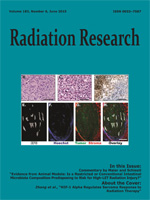Although there has been extensive research done on the biological response to doses of ionizing radiation relevant to radiodiagnostic procedures, very few studies have examined radiation schemes similar to those frequently utilized in CT exams. Instead of a single exposure, CT exams are often made up of a series of scans separated on the order of minutes. DNA damage dose-response kinetics after radiation doses and schemes similar to CT protocols were established in both cultured (ESW-WT3) and whole blood lymphocytes and compared to higher dose exposures. Both the kinetics and extent of H2AX phosphorylation were found to be dose dependent. Damage induction and detection showed a clear dose response, albeit different, at all time points and differences in the DNA repair kinetics of ESW-WT3 and whole blood lymphocytes were characterized. Moreover, using a modified split-dose in vitro experiment, we show that phosphorylation of H2AX is significantly reduced after exposure to CT doses fractionated over a few minutes compared to the same total dose delivered as a single exposure. Because the split-dose exposures investigated here are more similar to those experienced during a CT examination, it is essential to understand why and how these differences occur. This work provides compelling evidence supporting differential biological responses not only between high and low doses, but also between single and multiple exposures to low doses of ionizing radiation.
How to translate text using browser tools
26 May 2015
Investigation of DNA Damage Dose-Response Kinetics after Ionizing Radiation Schemes Similar to CT Protocols
S. Robin Elgart,
Maryam Bostani,
Karen C. Mok,
Ali Adibi,
Stefan Ruehm,
Dieter Enzmann,
Michael McNitt-Gray,
Keisuke S. Iwamoto
ACCESS THE FULL ARTICLE

Radiation Research
Vol. 183 • No. 6
June 2015
Vol. 183 • No. 6
June 2015




